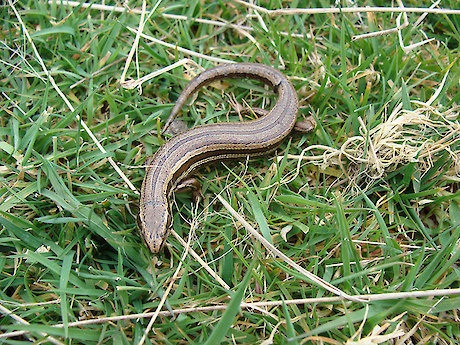Find out if skinks are at your place and learn how to make your place skink-friendly.
Simple observation
- Choose a hot sunny day to walk quietly around the site looking for skinks.
- Walk with the sun behind you so it casts a shadow on the area of vegetation where you are looking for skinks.
- If your shadow covers the skink it will quickly scurry for cover and you will hear rustling in the vegetation.
- If this happens sit quietly and observe the patch of vegetation where you heard the noise. Skinks will often return to their basking spot after a couple of minutes, so if you are patient you may get to see it come back.
- Record where the skink was found.
Monitoring skinks
Onduline stacks are a good way to monitor lizards in your garden. You can buy Onduline roofing material from Placemakers.
Cut a sheet into smaller pieces (290mm x 400mm) with a saw. The pieces can then be stacked two or three high with small stones between the layers and a large stone on top so they don’t blow away.
Once a month on a fine day check the stacks and record what you find. It may take a while for the lizards to use the stacks.
Can skinks get to your place?
Is your place connected to another place where skinks are likely to be? If you’re planning on making a skink-friendly garden, make sure it’s near an area of bush, scrub or an overgrown area.
Making a skink garden
There are several things to consider when making a skink-friendly garden. They need:
- Protective cover to hide in when looking for food
- Safe places to hide and rest when they’re not feeding
- Somewhere to bask in the sun
- Food – lots of bugs
Protective cover
Skinks need dense ground cover so they can search for food safely. To give skinks protection, use some of these plants.
- Divaricting (tangly) Coprosma species (eg: C. propinqua, C. acerosa, C. rhamnoides)
- Pohuehue vines (Muehlenbeckia complexa)
- Porcupine bush (Melicytus alpinus and M. crassifolius)
Contact the Southland Community Nursery for more information about these plants.
Secure retreats
Skinks need secure cover to hide in when they are not active. You can provide cover by putting logs, piles of rocks, planks of wood or corrugated iron in your garden.
Basking sites
Common skinks need basking sites that are in the sun for several hours per day (North facing sites are best). It is best to provide several basking sites so the skinks can follow the sun. You can use stones as they absorb and retain the heat or you can use Onduline stacks.
Food
Skinks need to have an adequate food supply. Bugs (invertebrates) make up the largest part of a lizards diet. Some of their favourite food items are beetles, flies, caterpillars, spiders and moths. You can encourage invertebrates into your garden by allowing leaf litter to build up, mulching heavily and by not using sprays.

